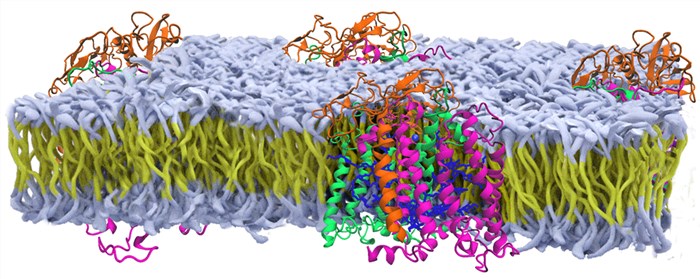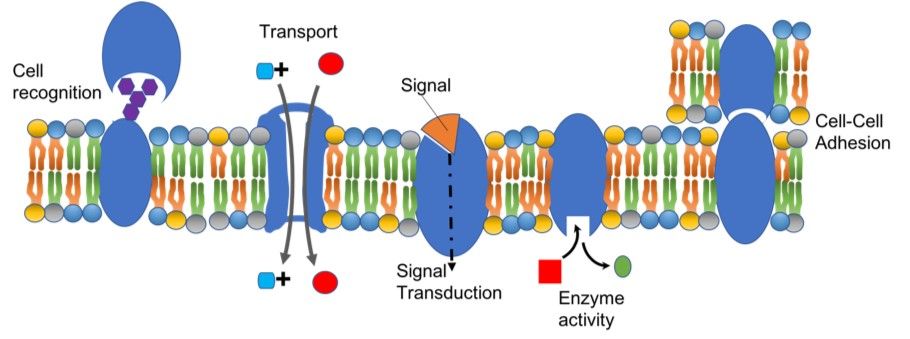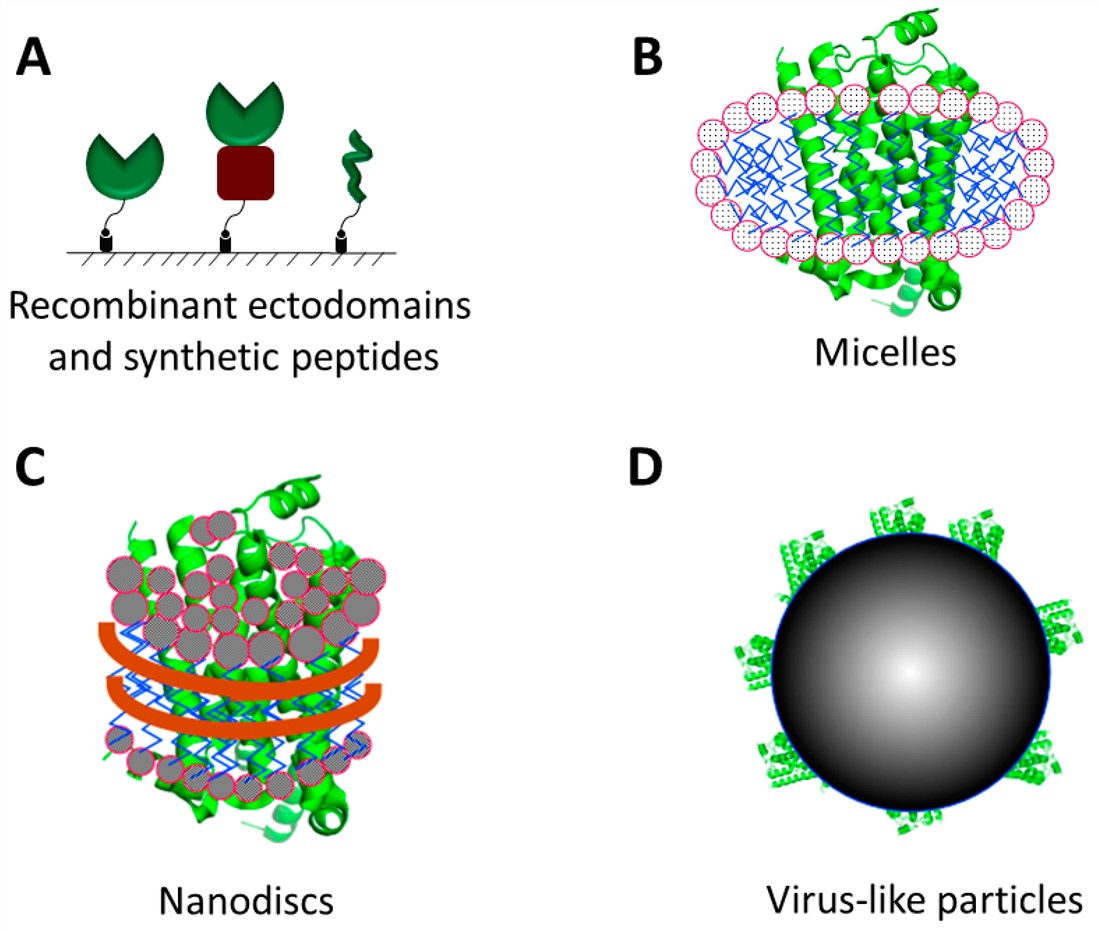Membrane Antibody
As a leader in the field of antibody discovery and engineering, Creative Biolabs offers membrane protein antibodies and related services. We have various membrane protein expression systems to obtain high-efficient expression of membrane proteins for following antibody development based on our multiple impeccable technologies. Our Hi-Affi™ Anti-Membrane Protein Antibody Discovery Services with our first-class Hi-Affi™ platform to generate high-quality antibody will meet your specific requirements.
Membrane Proteins
Membrane proteins are common proteins located in cell membranes, either at the surface or on intracellular organelles. Membrane proteins include several broad categories based on their location. Integral membrane protein is permanently anchored or part of the membrane. Peripheral membrane protein is only temporarily attached to the lipid bilayer or to other integral proteins. Membrane proteins play important roles in multiple biological processes such as ligand-receptor binding, signal transduction, molecule transportation, intercellular recognition, and cell adhesion. In human proteins, about a third of proteins are membrane proteins that are regarded as targets for more than half of all drugs.
 Fig.1 Structural model of membrane proteins.1,4
Fig.1 Structural model of membrane proteins.1,4
Structural of Membrane Proteins
Generally, integral membrane protein can be divided into two primary types (integral polytopic proteins and integral monotopic proteins) depending on their relationship with the bilayer. Integral polytopic proteins (also known as transmembrane proteins) can span across the membrane at least once. These integral membrane proteins present different transmembrane topology according to orientations of membrane-spanning segments. Integral membrane proteins display different forms such as, transmembrane α-helix protein, transmembrane α-helical protein and transmembrane β-sheet protein. Integral monotopic proteins are attached to only one side of the membrane and do not span the whole way across. There are 4 types of interaction between integral monotopic membrane protein and cell membranes: amphipathic α-helix parallel, hydrophobic loop, covalently bound membrane lipid and electrostatic or ionic interaction with membrane lipids.
Peripheral membrane proteins are another type of membrane proteins that only temporarily attach to the lipid bilayer or integral proteins through a combination of hydrophobic, electrostatic, and other non-covalent interactions.
Functions of Membrane Proteins
Membrane proteins play important roles in various biological processes serving as membrane receptors, ion channels, GPCR (G protein-coupled receptors) and various kinds of transport proteins. Membrane receptors can transmit signals between the cell’s internal and external environments embedded in the cell membranes. Some membrane transport proteins are necessary for the movement of ions, small molecules, or macromolecules across a biological membrane. Membrane transport proteins also function in ion channels to create a resting membrane potential, then form action potentials and other electrical signals by gating the flow of ions across the cell membrane, regulate the flow of ions across secretory and epithelial cells, and mediate cell volume. Some membranes proteins serve as enzymes such as oxidoreductase, transferase or hydrolase. Membrane proteins as cell adhesion molecules located on the cell surface are associated with the binding with other cells or with the extracellular matrix (ECM). One example is the Ig (immunoglobulin) superfamily involved in the immune response.
 Fig.2 Functions of membrane proteins.2
Fig.2 Functions of membrane proteins.2
Membrane Proteins Antibody
Membrane proteins are associated with many cellular functions, thus they are important targets for therapeutic antibody (mAb) discovery and diagnostic assays. To date, membrane proteins are considered as the targets of more than 40% drug, but only a few have been successfully targeted by antibodies.
Besides, the performance of the majority of these antibodies against membrane proteins is still poor. Their utility is generally limited to research applications. Membrane protein antibodies used in functional assays with living cells are rare and difficult and expensive to make.
Membrane proteins often exert their functions by three-dimensional structure. Thus, an antibody producing a physiologic effect on a cell must bind to the structure of a protein as it exists in the intact membrane. In living cells, only the extracellular regions of membrane proteins are available for antibody binding. To develop high-performance antibodies to membrane protein, it is essential to immunize animals and select antibodies that recognize membrane-dependent protein antigen structures that are large enough to achieve numerous contacts with antibody and high-affinity binding. Short linear peptide antigens do not represent significant portions of membrane proteins extracellular domains due to they are do not fold into native 3D structures. Recombinant full-length membrane proteins contain all of the extracellular regions, but they lack the membrane and are not folded into native structures useful for functional antibody development.
Currently, virus-like particles (VLPs) and transfected cells expressing the membrane proteins are frequently used for antibody development. However, these approaches also are limited due to the existence of other nontarget proteins that create a needle in a haystack problem.
Due to the value and the urgent need for functional mAbs, Creative Biolabs has well-established methods for the development of high-performance antibodies to membrane proteins.
 Fig.3 Different formats for presenting membrane proteins for affinity selection experiments.3,4
Fig.3 Different formats for presenting membrane proteins for affinity selection experiments.3,4
Despite there are still great challenges in the preparation of high-performance antibodies to membrane proteins. Creative Biolabs is still equipped with many strategies for the production of membrane proteins and membrane proteins antibodies. In terms of years’ professional experience in this field, we provide you an effective approach with the advanced platform, quick turnaround, and uncompromising quality results to obtain quality membrane protein antibodies. If you have any special requirements, please feel free to contact us.
Our membrane protein antibody related services include:
- Cell-based Membrane Protein Expression
- Cell-free Membrane Protein Expression
- Anti-Membrane Protein Antibody Production Using Membrane Protein VLPs
- Anti-Membrane Protein Antibody Production Using Proteoliposomes
- Anti-Membrane Protein Antibody Production Using Nanodiscs
- Anti-Membrane Protein Antibody Production Using Polymers
- Anti-Membrane Protein Antibody Production by Whole Cell Antigen Presentation
- Anti-Membrane Protein Antibody Production Using Designed Peptides
- Anti-Membrane Antibody Production by DNA Immunization
References
- Allen, James P. "Recent innovations in membrane-protein structural biology." F1000Research 8 (2019).
- From Wikipedia: By Connectivid-D - Own work, CC BY-SA 4.0, without modification. https://commons.wikimedia.org/wiki/File:Membrane_Protein_Structure.png
- Huang, Renhua, et al. "Generating recombinant antibodies to membrane proteins through phage display." Antibodies 5.2 (2016): 11.
- Distributed under Open Access license CC BY 4.0, without modification.


